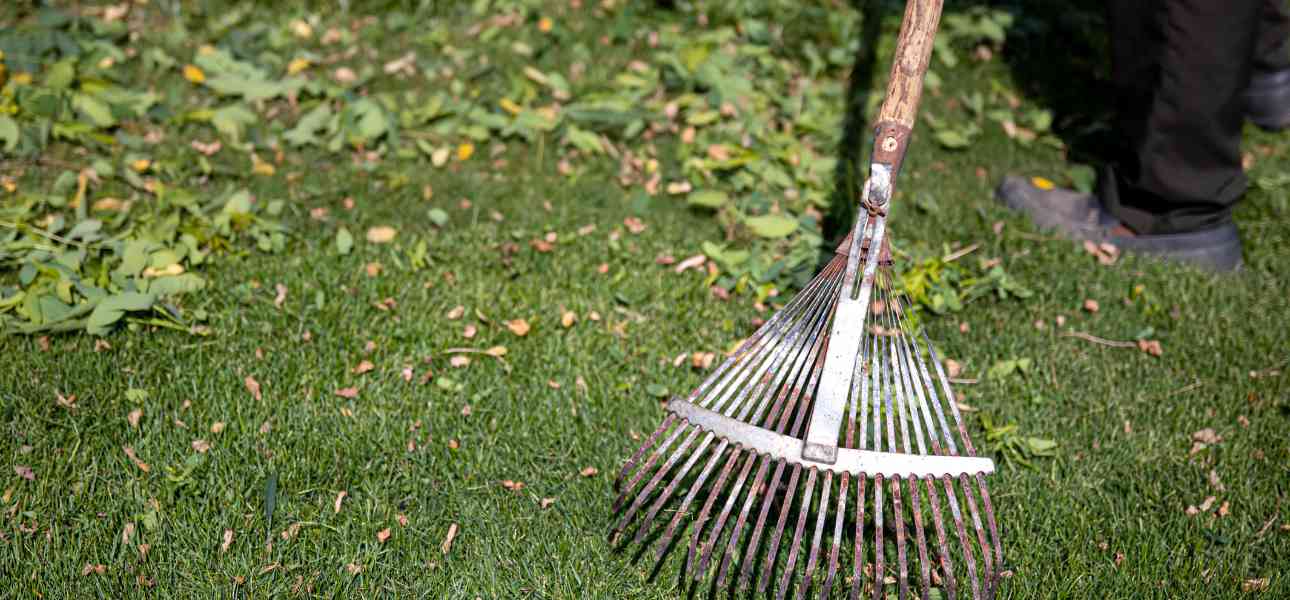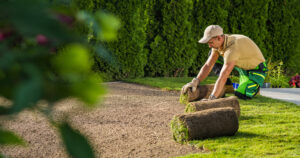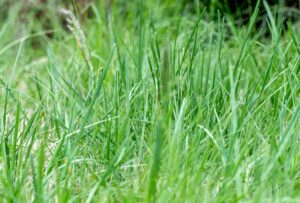Best Dethatching Rake for Lawn: Transform Your Turf With These Top Tools
![Multiple dethatching rakes arranged on a lawn with visible thatch being removed]
When thick thatch smothers your lawn, the right dethatching rake becomes essential for restoring healthy growth. Our comprehensive testing reveals which models effectively remove dead grass without damaging healthy turf.
Bottom Line Up Front
The Ames 15″ Adjustable Thatch Rake stands out as our top pick, combining excellent performance, sturdy construction, and an adjustable head to effectively clear thatch while protecting your lawn’s health. For budget-conscious homeowners, the Anvil 51″ Wood Handle Steel 14-Tine Bow Rake offers surprisingly effective dethatching capability in a multi-purpose tool.
What Is Thatch and Why Remove It?
Thatch is that layer of dead grass, roots, and organic debris that accumulates between your lawn’s green blades and the soil surface. While a thin layer (under ½-inch) provides nutrients to your lawn, thicker accumulations prevent water, air, and nutrients from reaching the soil, ultimately stifling healthy grass growth. Removing excessive thatch is crucial for maintaining a vibrant lawn that can efficiently absorb the resources it needs.
How We Tested
Our comprehensive evaluation process involved marking off multiple equal-sized sections of thatch-covered lawn and testing each rake in real-world conditions. We assessed:
- Thatch Removal Efficiency: How effectively each rake pulled thatch from the lawn
- Turf Protection: Whether healthy grass remained intact during dethatching
- Ease of Use: Physical effort required and overall comfort during operation
- Build Quality: Materials, construction, and likely longevity
- Value: Performance relative to price point

Best Overall: Ames 15″ Adjustable Thatch Rake
Rating: 4.5/5
Pros:
- Sturdy construction built for durability
- Well-designed curved and pointed tines that effectively grab thatch
- Adjustable head angle for precision dethatching
- Hardwood handle with rubber grip for comfort during extended use
- 19 tines provide excellent coverage and thatch removal
Cons:
- Heavier than some competitors
- Learning curve to find optimal head angle
- Requires significant physical effort for larger lawns
Why We Love It: The Ames dethatching rake combines smart design with exceptional durability, making it ideal for homeowners with small to medium-sized lawns. Its formidable curved tines taper to sharp points, allowing them to effectively pull up thatch while minimizing damage to healthy grass. During testing, after some initial adjustments to find the right angle, this rake removed impressive amounts of thatch with each pull while leaving the underlying healthy turf intact.
The hardwood handle provides excellent leverage, though its sturdiness does contribute to a heavier overall weight. For homeowners serious about lawn maintenance, this rake represents an excellent investment that will serve for many seasons of dethatching.
Best For: Homeowners with small to medium-sized lawns who want a durable, effective manual dethatching tool that will last for years.
Best Value: Anvil 51″ Wood Handle Steel 14-Tine Bow Rake
Rating: 4/5
Pros:
- Extremely affordable compared to specialized dethatching rakes
- Versatile tool useful for multiple landscaping tasks
- Durable steel and hardwood construction
- Effective at removing moderate thatch when used properly
Cons:
- Not specifically designed for dethatching
- Requires more physical effort than specialized tools
- Less precise than dedicated dethatching rakes
Why We Love It: Despite not being specifically designed for dethatching, this multi-purpose bow rake proved surprisingly effective at removing thatch during our tests. After finding the optimal angle of attack, it successfully pulled up thatch while causing minimal damage to healthy grass. Its sturdy construction featuring hardwood handle and durable metal rake head ensures longevity across various landscaping tasks.
The exceptional value proposition makes this rake particularly suitable for homeowners with smaller lawns or those dealing with only occasional, minor thatch issues. Since it doubles as a standard garden rake, it won’t take up extra storage space for a single-purpose tool.
Best For: Budget-conscious homeowners with smaller lawns who prefer multi-purpose tools and don’t need to dethatch frequently.
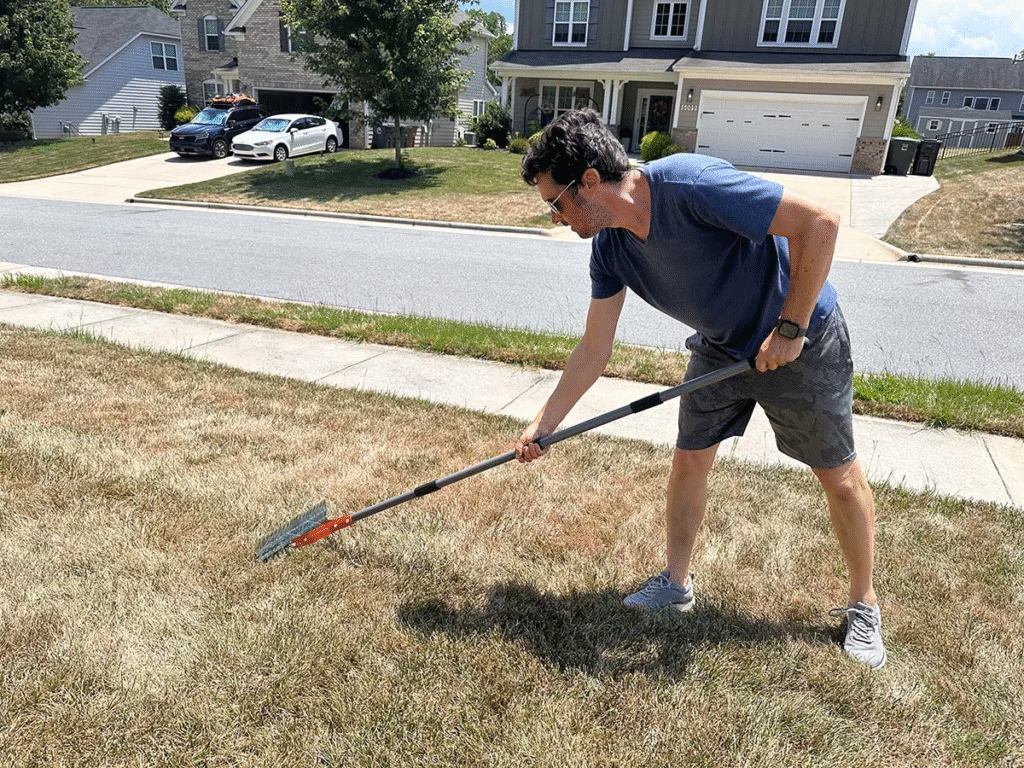
Best Premium Manual Option: Wolf-Garten Interlocken Dethatching Rake
Rating: 4.5/5
Pros:
- Thin, curved tines that minimize lawn damage
- Extremely durable steel construction
- Adjustable head angle for precision dethatching
- Part of interchangeable tool system for versatility
- Professional-grade quality
Cons:
- Handle sold separately
- Narrower head (12 inches) than some competitors
- Higher price point when factoring in handle cost
Why We Love It: The Wolf-Garten dethatching rake features exceptionally well-designed hook-shaped tines that dig effectively into thatch while causing minimal damage to healthy grass. During testing, this rake removed thatch with impressive efficiency and provided excellent control due to its lightweight design when paired with the fiberglass handle (sold separately).
The adjustable head allows for customized angles based on thatch thickness and grass type. While the narrower 12-inch head covers less ground per stroke than wider models, the precision it offers may be worth the trade-off for meticulous lawn caretakers.
This rake represents an excellent investment for those already using the Wolf-Garten Interlocken system, as the same handle works with numerous other garden tool attachments.
Best For: Detail-oriented lawn enthusiasts willing to invest in premium tools, especially those already using Wolf-Garten Interlocken system components.
Best Wheeled Option: Wolf-Garten Scarifying Roller Rake
Rating: 4/5
Pros:
- Wheels maintain consistent height for even dethatching
- Easier to operate than standard manual rakes
- Durable steel construction
- Rolling design reduces back strain
- Provides consistent dethatching depth
Cons:
- Handle sold separately
- Higher price point
- Requires more storage space than standard rakes
- Less effective in very tight spaces
Why We Love It: The Wolf-Garten scarifying roller rake innovates on the standard dethatching rake design by incorporating wheels that maintain a consistent height during operation. This design ensures the rake maintains the optimal depth for removing thatch without damaging the underlying soil and grass roots. During testing, the wheels provided noticeable benefits by reducing strain and delivering more consistent results across the entire lawn.
The wheeled design is particularly beneficial for homeowners who find traditional dethatching physically demanding, as it reduces the need for repetitive lifting motions. While still requiring effort to pull across the lawn, it proves significantly less strenuous than standard manual rakes.
Best For: Homeowners seeking less physically demanding manual dethatching and those who value consistency in their lawn care results.

Most Versatile: Walensee 15″ Thatch Rake With Adjustable Steel Handle
Rating: 4.5/5
Pros:
- Lightweight design reduces fatigue
- Adjustable head angle for precision work
- Adjustable handle length for different users
- Effective curved tines
- Excellent value for the quality offered
Cons:
- Head wing nuts can loosen during use
- Steel handle may be less comfortable than wood for some users
- Not as durable as premium wood-handled options
Why We Love It: The Walensee dethatching rake impressed with its adaptability and performance during testing. Its curved tines effectively bit into the soil, removing substantial thatch with each pull. The adjustable head angle allows for customization based on thatch thickness and turf conditions, though we found the wing nuts required regular tightening to maintain the desired angle.
The modular steel handle allows for length adjustment, making this rake suitable for users of different heights and for reaching under obstacles like low-hanging trees or shrubs. Despite initial skepticism about the sectional handle’s stability, once assembled, it proved remarkably strong while remaining significantly lighter than solid hardwood handles.
Best For: Households with multiple users of different heights or those who need a lightweight yet effective dethatching solution.
Best Powered Alternative: Sun Joe 12.6″ Electric Lawn Dethatcher + Scarifier
Rating: 4.5/5
Pros:
- Removes large amounts of thatch quickly with minimal effort
- Lightweight design makes it easy to maneuver
- Dual function as both dethatcher and scarifier
- Electric operation eliminates emissions
- Adjustable dethatching depth
Cons:
- Collection bag ineffective at catching thatch
- Requires power outlet and extension cord
- Higher price point than manual options
- Limited maneuverability in tight spaces
Why We Love It: For larger lawns where manual dethatching would be prohibitively time-consuming, the Sun Joe electric dethatcher provides an excellent powered alternative. During testing, its powerful 12-amp motor made short work of even thick thatch layers, pulling up significant amounts with each pass. At only 21 pounds, it proved easy to maneuver around the yard.
The unit’s versatility is enhanced by its dual-function capability, with separate dethatching and scarifying cylinders for different lawn maintenance needs. The scarifier attachment digs deeper to aerate soil and remove moss alongside thatch. While the included collection bag proved largely ineffective in our tests, the machine’s thatch removal performance was impressive enough to overlook this drawback.
Best For: Homeowners with medium to large lawns looking to minimize physical exertion while maximizing dethatching efficiency.

When to Dethatch Your Lawn
The ideal time for dethatching is during your lawn’s active growing season when it can recover quickly from the stress of the process. For most cool-season grasses, early fall or spring provides optimal conditions. Warm-season grasses typically respond best to late spring dethatching.
Experts recommend dethatching when thatch exceeds ½-inch in thickness. You can check your thatch layer by removing a small, 2-inch deep sample from your lawn and measuring the brown, spongy layer between the green grass and soil.
Signs Your Lawn Needs Dethatching
- Spongy feeling when walking across the lawn
- Water running off rather than absorbing into soil
- Increasing lawn disease or pest problems
- Declining grass health despite proper fertilization and watering
- Visible layer of brown material above soil level
- Difficulty pushing a screwdriver through to the soil
How to Use a Dethatching Rake Effectively
For best results when using a manual dethatching rake:
- Mow your lawn slightly shorter than normal before dethatching
- Water lightly 2 days before to ensure soil is moist but not wet
- Adjust rake head to appropriate angle based on thatch thickness
- Use short, firm strokes pulling the rake toward you
- Work in sections moving across the lawn methodically
- Rake in two directions for thorough thatch removal
- Remove loosened thatch with a standard leaf rake
- Water thoroughly after dethatching to reduce stress on grass
- Consider overseeding bare patches exposed during the process
Lawn Types and Dethatching Considerations
Different grass types have varying thatch accumulation tendencies. Kentucky bluegrass, Bermudagrass, and some fescues typically develop thicker thatch layers and benefit from regular dethatching. Clumping grasses like perennial ryegrass are less prone to excessive thatch buildup.
Note that dethatching can be stressful on a lawn and should be approached cautiously with warm-season grasses like St. Augustine or Bermuda. The process should also be avoided during extreme heat or when actively growing new seedlings.
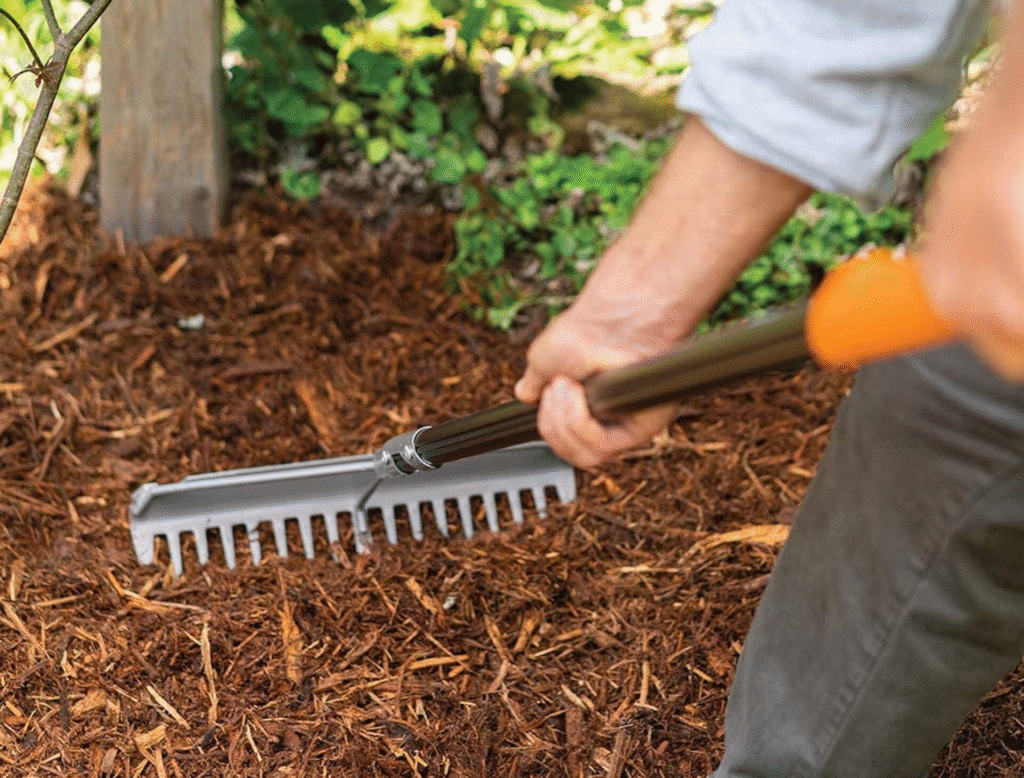
Manual vs. Powered Dethatchers: Which Is Right For You?
Manual Dethatching Rakes
Best for: Small to medium lawns, precision work around obstacles, budget-conscious homeowners Advantages: Affordable, no maintenance required, precise control, no noise or emissions Drawbacks: Physically demanding, time-consuming for larger areas
Powered Dethatchers
Best for: Medium to large lawns, reduced physical effort, frequent dethatching needs Advantages: Faster operation, less physical strain, consistent depth control Drawbacks: Higher cost, storage requirements, maintenance needs, less precision
Tow-Behind Dethatchers
Best for: Large properties, homeowners with riding mowers or tractors Advantages: Maximum coverage efficiency, minimal physical effort Drawbacks: Significant storage space required, less effective around obstacles and tight spaces
Caring for Your Dethatching Rake
To extend the life of your dethatching rake:
- Clean thoroughly after each use, removing all grass and soil
- Inspect tines regularly for bending or damage
- Tighten all bolts and screws before each use
- Store in a dry location to prevent rust and wood deterioration
- Apply linseed oil annually to wooden handles
- Sharpen tines if they become dull to maintain effectiveness
The Bottom Line
A quality dethatching rake represents an essential investment for maintaining a healthy, vibrant lawn. While powered options offer convenience for larger properties, manual dethatching rakes provide precise control and excellent results for most home lawns at a fraction of the cost.
The Ames 15″ Adjustable Thatch Rake earns our top recommendation for its exceptional performance, durable construction, and reasonable price point. For those seeking a multi-purpose option, the Anvil Bow Rake delivers surprising effectiveness while serving multiple gardening functions, making it an outstanding value.
By incorporating regular dethatching into your lawn care routine with one of these top-performing tools, you’ll ensure your grass has the optimal environment for robust growth and vibrant health throughout the growing season.
Our testing methodology: All products featured were thoroughly evaluated in identical lawn conditions with moderate to heavy thatch buildup. Each rake was used across multiple testing sessions by two evaluators to account for different physical capabilities and techniques. Ratings reflect consensus scores based on predefined performance criteria.
